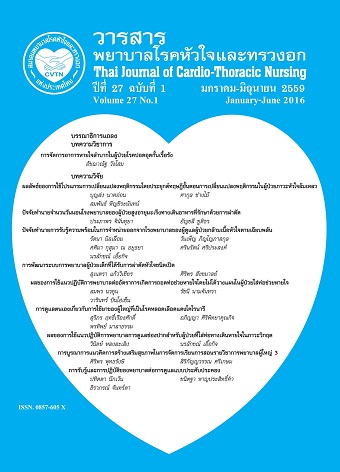ผลของการใช้แนวปฏิบัติการพยาบาลการดูแลช่องปากสำหรับผู้ป่วย ที่ใส่ท่อทางเดินหายใจในภาวะวิกฤต
Keywords:
การดูแลช่องปาก, ผู้ป่วยที่ใส่ท่อทางเดินหายใจ, แนวปฏิบัติการพยาบาล, ปอดอักเสบจากการใช้เครื่องช่วยหายใจ, oral care, patients with endotracheal tubes, clinical nursing practice guideline, ventilator associated pneumonia (VAP)Abstract
การวิจัยเชิงกึ่งทดลองนี้ มีวัตถุประสงค์เพื่อศึกษาผลของการใช้แนวปฏิบัติการพยาบาลการดูแลช่องปากสำหรับผู้ป่วยที่ใส่ท่อทางเดินหายใจในภาวะวิกฤต ณ แผนกงานการพยาบาลผู้ป่วยวิกฤตโรคหัวใจ (CCU) โรงพยาบาลธรรมศาสตร์เฉลิมพระเกียรติ คัดเลือกกลุ่มตัวอย่างแบบเจาะจง แบ่งเป็นกลุ่มควบคุม 30 คน และกลุ่มทดลอง 30 คน เครื่องมือที่ใช้ในการวิจัย ได้แก่ แบบรายงานการติดเชื้อการวินิจฉัยปอดอักเสบจากการใช้เครื่องช่วยหายใจ แบบประเมินสภาพช่องปาก แบบประเมินความพึงพอใจของผู้ป่วยในการดูแลช่องปาก แนวปฏิบัติการพยาบาลการดูแลช่องปาก และเทคนิคการทำความสะอาดช่องปากสำหรับผู้ป่วยที่ใส่ท่อทางเดินหายใจ ใน CCU วิเคราะห์ข้อมูลโดยใช้สถิติเชิงพรรณนา สถิติทดสอบที และสถิติ Fisher’s exact test
ผลการวิจัยพบว่า ผู้ป่วยที่ใส่ท่อทางเดินหายใจในภาวะวิกฤตกลุ่มทดลองมีคะแนนเฉลี่ยความสะอาดในช่องปากดีกว่ากลุ่มควบคุมอย่างมีนัยสำคัญทางสถิติที่ระดับ .05 ผู้ป่วยในกลุ่มควบคุมมีอัตราการเกิดปอดอักเสบจากการใช้เครื่องช่วยหายใจคิดเป็นร้อยละ 93.3 ในขณะที่กลุ่มทดลองพบเพียงร้อยละ 10 กลุ่มทดลองมีค่าคะแนนเฉลี่ยจำนวนวันใส่ท่อทางเดินหายใจน้อยกว่ากลุ่มควบคุมอย่างมีนัยสำคัญทางสถิติที่ระดับ .05 และกลุ่มทดลองมีระดับความพึงพอใจเกี่ยวกับการดูแลความสะอาดในช่องปากมากกว่ากลุ่มควบคุม อย่างมีนัยสำคัญทางสถิติที่ระดับ .05
ข้อเสนอแนะจากงานวิจัย พยาบาลสามารถนำหลักฐานเชิงประจักษ์นี้ไปใช้ในการดูแลความสะอาดในช่องปากของผู้ป่วยที่ใส่ท่อทางเดินหายใจในภาวะวิกฤตไปใช้ในหน่วยวิกฤตต่างๆ เพื่อป้องกันการเกิดการติดเชื้อในระบบทางเดินหายใจ
The effect of a clinical nursing practice guideline for oral care in critical patients with endotracheal tubes
The purpose of this quasi-experimental study was to compare the effects of clinical nursing practice guideline for oral care among the critical patients with endotracheal tubes at Cardiac Care Unit (CCU), Thammasat University Hospital. The patients were selected by purposive sampling method and were divided into two groups with 30 participants each: the experimental group and the control group. The research instruments included report of infection with ventilator-associated pneumonia, oral assessment, and patients’ satisfaction of oral care assessment, guideline for oral care, and technique of oral care among the patients with endotracheal tubes at CCU. Data were analyzed using descriptive statistic, Independent t-test and Fisher’s exact test.
The findings of this study showed that the patients with endotracheal tubes of experimental group had significantly higher scores for oral cleanliness assessment than those of control group (p <.05). The incidence of ventilator associated pneumonia (VAP) in the control group was 93.3%, in contrast to only 10% of those of the experimental group. Furthermore, the experimental group had an average duration of endotracheal intubation shorter than those in a control group with statistically significant (p<.05). And lastly, there was statistically significant between mean scores of patients’ satisfaction for an experimental group and a control group (p<.05).
It should be suggested that this evidence based practice could be used to improve nursing care provision of oral care for critically ill patients with endotracheal tubes to prevent (VAP) at other critical care settings.
Downloads
How to Cite
Issue
Section
License
บทความนี้ยังไม่เคยตีพิมพ์หรืออยู่ในระหว่างส่งไปตีพิมพ์ในวารสารอื่น ๆ มาก่อน และกองบรรณาธิการขอสงวนสิทธิ์ในการตรวจทาน และแก้ไขต้นฉบับตามเกณฑ์ของวารสาร ในกรณีที่เรื่องของท่านได้ได้รับการตีพิมพ์ในวารสารฉบับนี้ถือว่าเป็น ลิขสิทธิ์ของวารสารพยาบาลโรคหัวใจและทรวงอก






